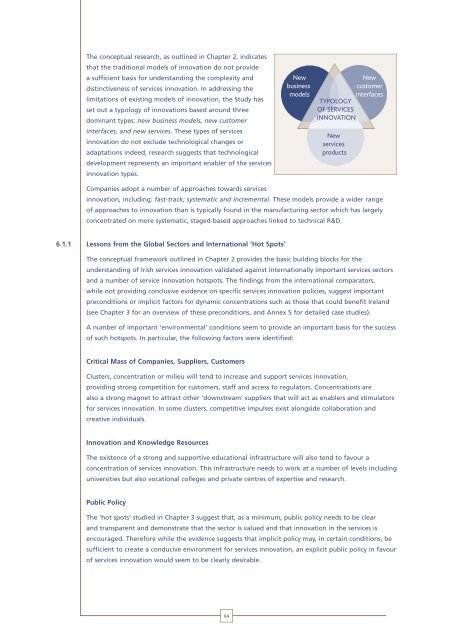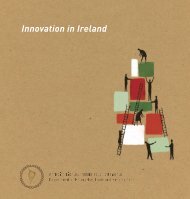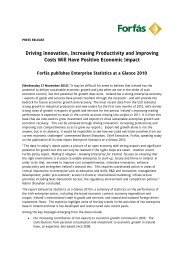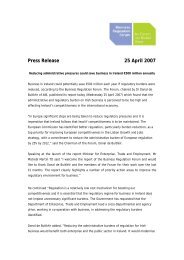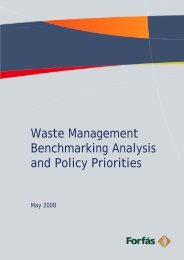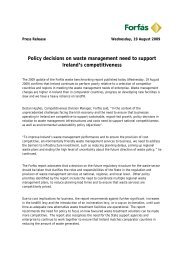Services Innovation in Ireland - Options for ... - Europe INNOVA
Services Innovation in Ireland - Options for ... - Europe INNOVA
Services Innovation in Ireland - Options for ... - Europe INNOVA
Create successful ePaper yourself
Turn your PDF publications into a flip-book with our unique Google optimized e-Paper software.
The conceptual research, as outl<strong>in</strong>ed <strong>in</strong> Chapter 2, <strong>in</strong>dicates<br />
that the traditional models of <strong>in</strong>novation do not provide<br />
a sufficient basis <strong>for</strong> understand<strong>in</strong>g the complexity and<br />
dist<strong>in</strong>ctiveness of services <strong>in</strong>novation. In address<strong>in</strong>g the<br />
limitations of exist<strong>in</strong>g models of <strong>in</strong>novation, the Study has<br />
set out a typology of <strong>in</strong>novations based around three<br />
dom<strong>in</strong>ant types: new bus<strong>in</strong>ess models, new customer<br />
<strong>in</strong>terfaces, and new services. These types of services<br />
<strong>in</strong>novation do not exclude technological changes or<br />
adaptations <strong>in</strong>deed, research suggests that technological<br />
development represents an important enabler of the services<br />
<strong>in</strong>novation types.<br />
Companies adopt a number of approaches towards services<br />
<strong>in</strong>novation, <strong>in</strong>clud<strong>in</strong>g: fast-track; systematic and <strong>in</strong>cremental. These models provide a wider range<br />
of approaches to <strong>in</strong>novation than is typically found <strong>in</strong> the manufactur<strong>in</strong>g sector which has largely<br />
concentrated on more systematic, staged-based approaches l<strong>in</strong>ked to technical R&D.<br />
6.1.1 Lessons from the Global Sectors and International ‘Hot Spots’<br />
The conceptual framework outl<strong>in</strong>ed <strong>in</strong> Chapter 2 provides the basic build<strong>in</strong>g blocks <strong>for</strong> the<br />
understand<strong>in</strong>g of Irish services <strong>in</strong>novation validated aga<strong>in</strong>st <strong>in</strong>ternationally important services sectors<br />
and a number of service <strong>in</strong>novation hotspots. The f<strong>in</strong>d<strong>in</strong>gs from the <strong>in</strong>ternational comparators,<br />
while not provid<strong>in</strong>g conclusive evidence on specific services <strong>in</strong>novation policies, suggest important<br />
preconditions or implicit factors <strong>for</strong> dynamic concentrations such as those that could benefit <strong>Ireland</strong><br />
(see Chapter 3 <strong>for</strong> an overview of these preconditions, and Annex 5 <strong>for</strong> detailed case studies).<br />
A number of important ‘environmental’ conditions seem to provide an important basis <strong>for</strong> the success<br />
of such hotspots. In particular, the follow<strong>in</strong>g factors were identified:<br />
Critical Mass of Companies, Suppliers, Customers<br />
Clusters, concentration or milieu will tend to <strong>in</strong>crease and support services <strong>in</strong>novation,<br />
provid<strong>in</strong>g strong competition <strong>for</strong> customers, staff and access to regulators. Concentrations are<br />
also a strong magnet to attract other ‘downstream’ suppliers that will act as enablers and stimulators<br />
<strong>for</strong> services <strong>in</strong>novation. In some clusters, competitive impulses exist alongside collaboration and<br />
creative <strong>in</strong>dividuals.<br />
<strong>Innovation</strong> and Knowledge Resources<br />
The existence of a strong and supportive educational <strong>in</strong>frastructure will also tend to favour a<br />
concentration of services <strong>in</strong>novation. This <strong>in</strong>frastructure needs to work at a number of levels <strong>in</strong>clud<strong>in</strong>g<br />
universities but also vocational colleges and private centres of expertise and research.<br />
Public Policy<br />
The ‘hot spots’ studied <strong>in</strong> Chapter 3 suggest that, as a m<strong>in</strong>imum, public policy needs to be clear<br />
and transparent and demonstrate that the sector is valued and that <strong>in</strong>novation <strong>in</strong> the services is<br />
encouraged. There<strong>for</strong>e while the evidence suggests that implicit policy may, <strong>in</strong> certa<strong>in</strong> conditions, be<br />
sufficient to create a conducive environment <strong>for</strong> services <strong>in</strong>novation, an explicit public policy <strong>in</strong> favour<br />
of services <strong>in</strong>novation would seem to be clearly desirable.<br />
64<br />
New<br />
bus<strong>in</strong>ess<br />
models<br />
New<br />
customer<br />
<strong>in</strong>terfaces<br />
TYPOLOGY<br />
OF SERVICES<br />
<strong>INNOVA</strong>TION<br />
New<br />
services<br />
products


